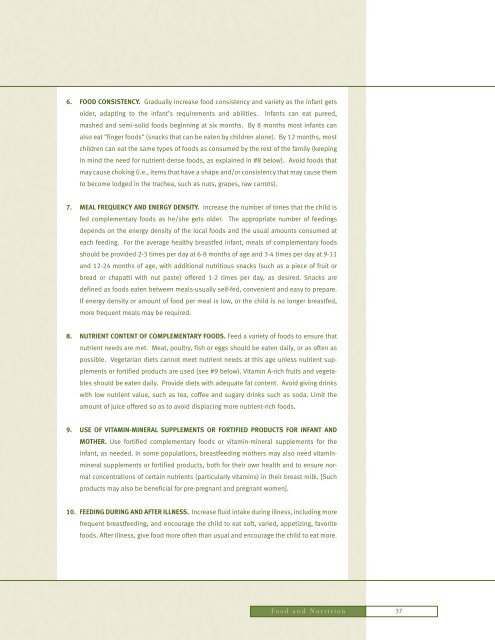Guiding Principles for Complementary Feeding of the Breastfed
Guiding Principles for Complementary Feeding of the Breastfed
Guiding Principles for Complementary Feeding of the Breastfed
You also want an ePaper? Increase the reach of your titles
YUMPU automatically turns print PDFs into web optimized ePapers that Google loves.
6. FOOD CONSISTENCY. Gradually increase food consistency and variety as <strong>the</strong> infant gets<br />
older, adapting to <strong>the</strong> infant’s requirements and abilities. Infants can eat pureed,<br />
mashed and semi-solid foods beginning at six months. By 8 months most infants can<br />
also eat "finger foods" (snacks that can be eaten by children alone). By 12 months, most<br />
children can eat <strong>the</strong> same types <strong>of</strong> foods as consumed by <strong>the</strong> rest <strong>of</strong> <strong>the</strong> family (keeping<br />
in mind <strong>the</strong> need <strong>for</strong> nutrient-dense foods, as explained in #8 below). Avoid foods that<br />
may cause choking (i.e., items that have a shape and/or consistency that may cause <strong>the</strong>m<br />
to become lodged in <strong>the</strong> trachea, such as nuts, grapes, raw carrots).<br />
7. MEAL FREQUENCY AND ENERGY DENSITY. Increase <strong>the</strong> number <strong>of</strong> times that <strong>the</strong> child is<br />
fed complementary foods as he/she gets older. The appropriate number <strong>of</strong> feedings<br />
depends on <strong>the</strong> energy density <strong>of</strong> <strong>the</strong> local foods and <strong>the</strong> usual amounts consumed at<br />
each feeding. For <strong>the</strong> average healthy breastfed infant, meals <strong>of</strong> complementary foods<br />
should be provided 2-3 times per day at 6-8 months <strong>of</strong> age and 3-4 times per day at 9-11<br />
and 12-24 months <strong>of</strong> age, with additional nutritious snacks (such as a piece <strong>of</strong> fruit or<br />
bread or chapatti with nut paste) <strong>of</strong>fered 1-2 times per day, as desired. Snacks are<br />
defined as foods eaten between meals-usually self-fed, convenient and easy to prepare.<br />
If energy density or amount <strong>of</strong> food per meal is low, or <strong>the</strong> child is no longer breastfed,<br />
more frequent meals may be required.<br />
8. NUTRIENT CONTENT OF COMPLEMENTARY FOODS. Feed a variety <strong>of</strong> foods to ensure that<br />
nutrient needs are met. Meat, poultry, fish or eggs should be eaten daily, or as <strong>of</strong>ten as<br />
possible. Vegetarian diets cannot meet nutrient needs at this age unless nutrient supplements<br />
or <strong>for</strong>tified products are used (see #9 below). Vitamin A-rich fruits and vegetables<br />
should be eaten daily. Provide diets with adequate fat content. Avoid giving drinks<br />
with low nutrient value, such as tea, c<strong>of</strong>fee and sugary drinks such as soda. Limit <strong>the</strong><br />
amount <strong>of</strong> juice <strong>of</strong>fered so as to avoid displacing more nutrient-rich foods.<br />
9. USE OF VITAMIN-MINERAL SUPPLEMENTS OR FORTIFIED PRODUCTS FOR INFANT AND<br />
MOTHER. Use <strong>for</strong>tified complementary foods or vitamin-mineral supplements <strong>for</strong> <strong>the</strong><br />
infant, as needed. In some populations, breastfeeding mo<strong>the</strong>rs may also need vitaminmineral<br />
supplements or <strong>for</strong>tified products, both <strong>for</strong> <strong>the</strong>ir own health and to ensure normal<br />
concentrations <strong>of</strong> certain nutrients (particularly vitamins) in <strong>the</strong>ir breast milk. [Such<br />
products may also be beneficial <strong>for</strong> pre-pregnant and pregnant women].<br />
10. FEEDING DURING AND AFTER ILLNESS. Increase fluid intake during illness, including more<br />
frequent breastfeeding, and encourage <strong>the</strong> child to eat s<strong>of</strong>t, varied, appetizing, favorite<br />
foods. After illness, give food more <strong>of</strong>ten than usual and encourage <strong>the</strong> child to eat more.<br />
Food and Nutrition<br />
37

















